newbeedrone Bee Brain Light Brushless Flight Controller
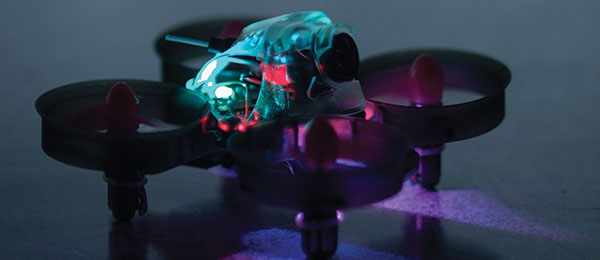
Written by Matt Ruddick An innovative brushed flight controller As seen in the May 2019 issue of Model Aviation
Bonus Video
Product Review
newbeedrone has been a leader in the micro drone market since the introduction of its first Betaflight-powered BeeBrain flight controller more than two years ago. Now, in 2019, the company is innovating once again with the new BeeBrain Lite flight controller for brushed micro quadcopters. Using the same form factor as previous models, the overall look of the BeeBrain Lite won’t surprise anyone who is familiar with micro quads. The preinstalled power lead extends from the rear, as well as the micro USB port for Betaflight programming. What you might not notice, however, are the components on the board itself. This new F4 flight controller features an integrated video transmitter (VTX) on the board to eliminate the need for a secondary circuit board to handle that function. It also features additional circuitry to allow for active braking—something that, until now, has only been seen on brushless drones. I’ll explain what all of that means later in this review.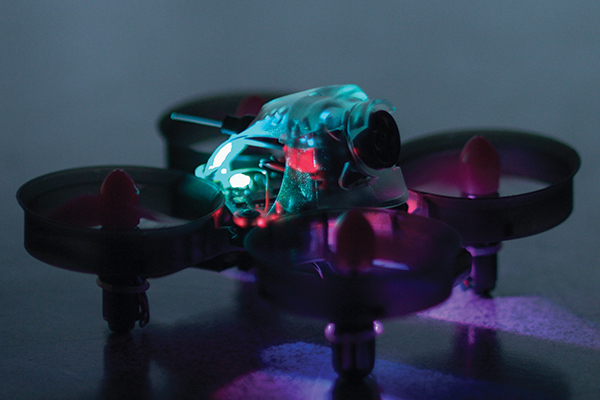
Betaflight addressable LEDs are a fun addition and allow for more customization.
As I mentioned, this flight controller features an F4 processor that is compatible with all of the latest Betaflight features and filters. Additionally, a full-range diversity receiver setup is present to make sure that you maintain a rock-solid signal throughout your flight. Coming in both FrSky and DSMX flavors, the external antenna handles much of the work, but the integrated PCB antenna gives you great signal performance when flying in noisy signal areas. NewBeeDrone designed a new on-screen display (OSD) chip using technology that requires 75% less power and 75% less space than its predecessors, allowing for longer flight times and better all-around flight performance, while still giving you the OSD information that you want during flight. New to this product is the inclusion of LEDs that can be programmed through the Betaflight interface. One LED on top of the board and two LEDs on the bottom give you a number of options for customizing the look of your quad, which will surely dazzle those watching as you slide through the air. I was able to set up a quick program in Betaflight’s LED interface to make my quad look like a police car with alternating blue and red lights. It definitely made for some exciting racing with other pilots!
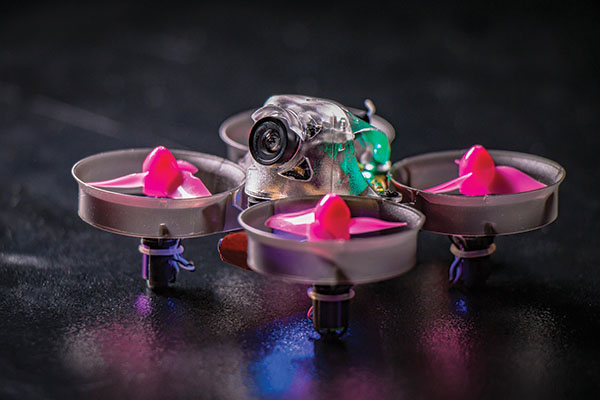
The new BeeBrain Lite flight controller is a user-friendly, easy-to-set-up board that runs Betaflight.
The onboard VTX features 40 channels, including Raceband, and is adjustable from 1 mW to 25 mW in power. Because it’s integrated into the flight controller, there is some weight savings by building this component into the board, and it lowers the height of the quad when compared with the BeeBrain V2’s setup. On the subject of the BeeBrain V2, the camera from that rig is fully compatible with the BeeBrain Lite and can be directly plugged into the onboard camera plug. This keeps the BeeBrain Lite setup completely solderless, similar to its predecessor. It also means that getting up and flying is as fast or faster than any other setup currently on the market. The most talked about feature of the new BeeBrain Lite is its inclusion of active braking. Commonly seen on larger brushless setups, active braking simply means that the motors can be immediately stopped when a new command is issued, as opposed to allowing its momentum to carry on (which is what is typically seen in brushed motors of this size and class). In theory, this means you’ll expect a more responsive feel and be able to perform aerobatic maneuvers more commonly done by larger aircraft. After pairing the BeeBrain Lite with a set of NewBeeDrone Gold motors, I was excited to try out some of these new features. I jumped into Betaflight, programmed my radio, and took some time to play with the LED features. After I settled on a color combination that I liked, I finally put the quad in the air.
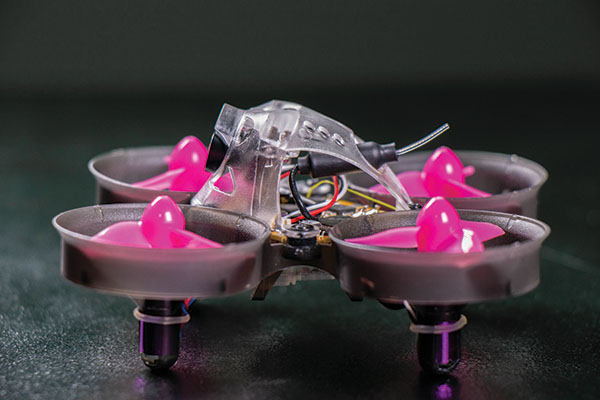
The sleek, new canopy provides extra aerodynamic benefits and can achieve better flight times.
I immediately noticed the responsiveness that the active braking provided. I expected that this would be more hype than anything else, but I was completely wrong. The BeeBrain Lite gave me a sense of being “locked in” like I never had before with a micro quadcopter. Flips and rolls were snappy and propwash was minimal, meaning I no longer feared that I might bounce off of the floor when flipping around. Without exaggerating, it really felt like a whole new experience. Using 300 mAh LiPo batteries, I got approximately 3.5- to 4-minute flight times, and radio link was never an issue for me. Although I wasn’t flying long range, I was flying around thick walls in a warehouse. The received signal strength indicator (RSSI) stayed consistently greater than 70 to 75. This was a nice improvement over other integrated receiver systems. How was the durability? I crashed this little guy—a lot—and I crashed hard. What I found out first was that spin recovery was excellent. There were many cases where I probably should have hit the ground, but I kept ricocheting off of walls and anything else around me and kept going. I didn’t experience any random reboots or power loss after hard crashes. I was pleased with how well it stood up to some abuse. Overall, I feel like this is one of the best micro boards on the market. It’s a huge improvement over the BeeBrain V2, of which I was a fan. It is incredibly user friendly, easy to set up, flies great, and should last a long time, which are all great things to consider when putting together a micro drone.
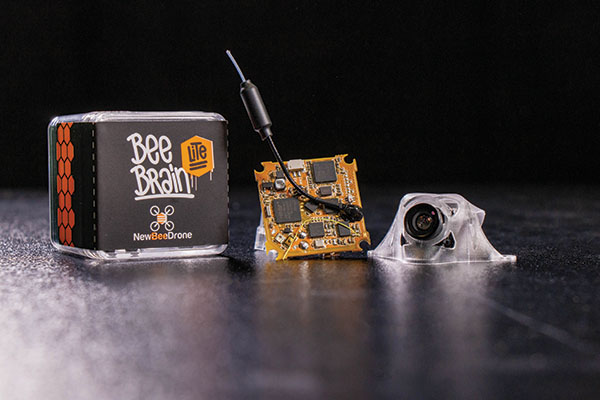










Add new comment